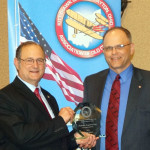WRIGHT-PATTERSON AIR FORCE BASE, Oh. — A new and unique Air Force Research Laboratory Sensors Directorate facility officially opened with a ribbon cutting ceremony on July 17. The Distributed Sensing Research Range (DiSeRR) will allow AFRL scientists and engineers to develop and explore advanced distributed sensing concepts in a realistic electromagnetic environment.
Located at the corner of Airway Road and Harshman Avenue on land owned by Wright Patterson AFB, the facility was designed to support research into distributed sensing where a number of geographically separated transmitters and receivers work together to gather information about objects and activities in an area of interest. The facility consists of a 200 meter ring of 12 non-uniformly spaced 20 meter tall towers connected to the DiSeRR building through underground fiber optic cables. This configuration allows scientists to simulate the performance of sensing systems that could be distributed amongst a group of unmanned aerial vehicles (UAVs). The facility will operate at very low power levels, less than 1 watt, though with enough power to enable researchers to test advanced sensing concepts and capabilities. Its location will allow the facility to work in concert with other base facilities in fresh new ways, enhancing the Sensors Directorate’s capabilities.
“The location of the DiSeRR, among commercial radio and TV stations, and cell towers, rather than away from such transmissions, enables development and testing of sensing systems that reliably operate in complex environments” said Gary Scalzi, AFRL Sensors Directorate, RF Range Technical Lead and host of the day’s ribbon-cutting event, “This will ensure sensing can be done without interfering with commercial or other military communications/signals and is critical for future Air Force systems that need to operate in highly congested radio frequency spectrum environments that now occur worldwide. It also enables AFRL to transition technology into systems with reduced cost and risk”.
Sensors Directorate researchers will initially perform experiments in areas of radio frequency tomography (similar to an X-Ray CAT scan but with radio frequency energy) and multi-static sensing; where the performance of large radar systems can be reproduced and improved using many smaller low cost systems operating in parallel. Future plans include exploring using transmissions that adapt the local radio frequency environment without interfering with commercial transmissions.
Source: WPAFB News



